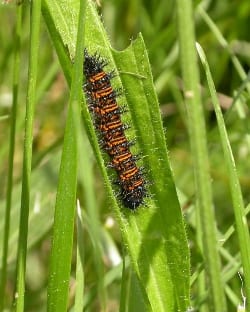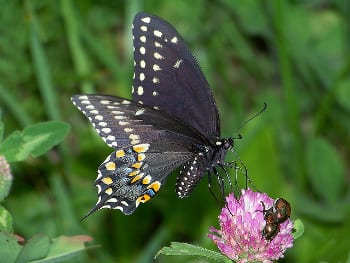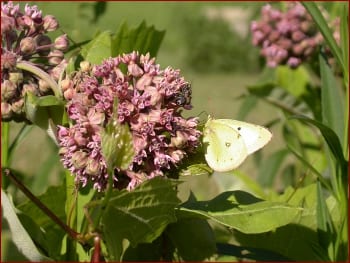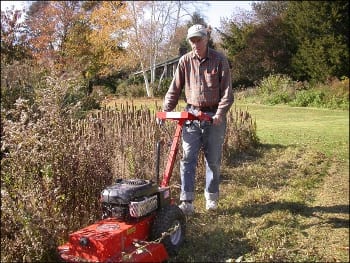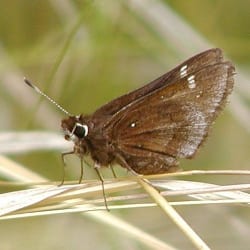by Sharon Stichter
Constructed landscapes can provide excellent habitat for many butterflies and other beneficial insects. For butterflies, a complete habitat includes both nectar sources for the adults and larval host plants for the next generation. There are many good sources of information about which plants to use. What is not generally known is that many of our butterfly species here in the northeast and elsewhere have adapted to using non-native and sometimes even invasive plants. In some cases the butterflies no longer use their original native host or nectar plant because it is not easily available or because it is in fact a less robust food source.
Non-native Hosts
The striking Black Swallowtail, for example, used native Siam and Cicuta spp (water hemlock and water parsnip) as host plants in the 19th century, but quickly adapted to agricultural environments and now uses almost exclusively Queen Anne’s Lace, parsley, dill, and fennel (Photo 1). I’ve never seen any reports of eggs or larvae on native plants in the parsley family, although it could occur. The beautiful Baltimore Checkerspot now thrives on introduced lance-leaved plantain (Photo 2), although it also still uses its native host plant, white turtlehead Chelone glabra, where it can be found.
Several charismatic butterfly species, such as the Red Admiral, the Question Mark, the Eastern Comma, and Milbert’s Tortoiseshell, utilize imported Stinging Nettles (Urtica dioica), because this plant has a longer growth period before senescence than do the native nettle species. The uncommon Bronze Copper butterfly uses common dock (Rumex crispus) almost exclusively. The bright little American Copper uses sheep sorrel, a widespread weed. A full list of butterfly species using non-native plants can be found at http://www.butterfliesofmassachusetts.net/history.htm. If we remove all such weedy and perhaps inconvenient plants from a restoration site, we are removing key host plants for native butterflies.
Nectar Sources
Just as some butterfly species have adopted non-native host plants, others utilize non-native nectar sources (Photo 3). Many bees and butterflies use the invasive purple loosestrife as an easily available energy source. Naturalized field clovers and meadow vetches are very important nectar sources. Buddleia bush in the garden is extremely popular with many species of butterfly. If we attempt to eradicate all such non-native nectar sources from our sites, we will also be eliminating the insects which use them, unless we plant good alternatives, such as common milkweed (Photo 4), liatris, and purple coneflower. For wetlands, I strongly recommend that when purple loosestrife is to be removed, swamp milkweed (Aesclepias incarnata) and joe-pye weed be planted in its place. Otherwise, some of our uncommon wetland butterflies, such as Mulberry Wing and Black Dash, whose larval hosts are sedges, and other butterflies that use wet meadows, will be adversely affected.
Mowing practices are another key factor affecting butterflies and other insects. Meadows are the quintessential butterfly habitat, but of course they quickly revert to shrubs and forests without mowing, grazing, or fire. Fire is often impractical, and can completely wipe out lepidoptera populations at a site. I usually recommend mechanical mowing, on a schedule which is coordinated with the butterfly life cycle.
Effective Mowing
The best practice, which will benefit the most species of butterflies, is to mow meadows no more than once per year, in the late fall. Keep the mower height at least 4 to 6 inches off the ground, since larvae will be over-wintering near the ground at the base of plants, and leave the cuttings in place to decompose over the winter (Photo 5). If possible, mow with a sickle bar to minimize damage to overwintering life forms. At each mowing, it is a good idea to leave some unmowed areas, even small ones, as “insect refugia.” A good way to accomplish this is to mow on a rotational basis, cutting only one-half or one-third of an area each year.
Dry stands of native Little Bluestem, and sandplain grasslands near the coast, provide habitat for uncommon species of butterflies such as Cobweb, Dusted, and Leonard’s Skippers (Photo 6). These areas can sometimes maintain themselves without mowing, which would be preferable. Native wet meadows are habitat for other uncommon but lovely species, such Harris’ Checkerspot, Baltimore Checkerspot, Silver-bordered Fritillary, and Bronze Copper. All colonies of these species should be protected. Mowing can be done around edges of wet and dry meadows if shrubs are encroaching, and individual shrubs can be spot-treated.
Some butterfly species prefer to lay their eggs on fresh new leaf growth, and their larvae do best on such vegetation. For this reason species such as Monarch, Cabbage White, Common Sulphur, Orange Sulphur and Black Swallowtail, all of which are agriculturally adapted, may actually benefit from a midsummer mowing in late July or August, since they are able to raise another brood before fall on the newly sprouted milkweed, clover, cresses, and Queen Anne’s Lace. On the other hand, single-brooded species, including Baltimore Checkerspot, Harris’ Checkerspot, and some skippers, can be wiped out by a midsummer mowing. It is best to determine what species of butterfly are present before deciding on when or whether to mow. For more information on mowing for butterflies, see http://www.naba.org/chapters/nabambc/butterfly-conservation.asp.
About the Author
Sharon Stichter is the Editor of Massachusetts Butterflies, a publication of the Massachusetts Butterfly Club (http://www.massbutterflies.org). She is also the author of Butterflies of Massachusetts, http://www.butterfliesofmassachusetts.net. This reference resource explains each of the butterfly species in Massachusetts, including those mentioned here, in an up-to-date Species Account, covering its history, host plants and habitat in the state, relative abundance, state distribution map, broods and flight time, and conservation outlook. Contact Sharon at sharonstichter@comcast.net.


